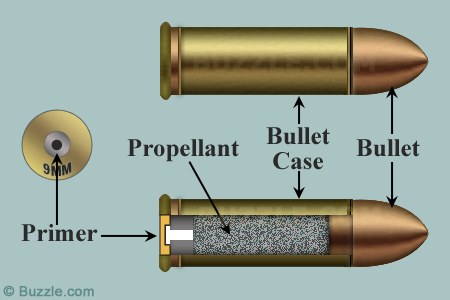5 Things About Personal-Defense Ammunition
Have you ever gone to the store to buy personal-defense ammunition and been completely confused by the number of options? Let’s break down the details, and hopefully your selection process will become easier.
Cartridge: This is the complete package of what you load into your gun. Some people also refer to it just as bullets or rounds. The cartridge consists of 4 parts: primer, powder, case and bullet.

Primer: A small cap at the base of the cartridge, containing a compound that explodes to ignite the powder.
Powder: A substance that burns rapidly to create gas pressure to propel the bullet out of the bore of the gun.
Case: Holds all the parts together. Although most commonly made of brass, there is now a wide variety available made of aluminum or steel to cut costs in manufacturing.
Bullet: The projectile crimped into the mouth of the case and propelled from the firearm.
Now that you have a better understanding of the parts of ammunition and how it works, let’s get a bit more technical. I talked to Dave Fricke at Lehigh Defense, a custom ammunition and projectile manufacturer, in order to shed some light on the variances in personal-defense ammunition. They make their own bullets for performance and to meet the Sporting Arms and Ammunition Manufacturers’ Institute (SAAMI) standards. Here are 5 things I learned about personal-defense ammunition from Lehigh Defense.
5 things you need to know about personal-defense ammunition
Personal-defense ammunition is different from typical ammunition
The point of personal-defense ammunition is to stop a threat in its tracks. The goal of the round is for the projectile to stop inside the body, causing the threat to absorb all of the bullet’s kinetic energy.
The energy formula
I know this part gets really technical, but when you understand the formula for kinetic energy, it all makes more sense. Luckily, I took Honors Physics in high school. The formula for kinetic energy is E=1/2mv2 where E is kinetic energy, m is mass and v is velocity. When you double the mass, you double the energy. If you want to quadruple the energy, all you have to do is double the velocity (since it is already to the 2nd power). Speed it up!
Benefits of low-recoil ammunition
When using a low-recoil, personal-defense round, a shooter can make the first shot, and also maintain a firm grip on the gun to make a fast second shot, if necessary. Lower recoil means the handgun returns to the point of aim sooner. After all, we train to shoot until the threat is gone. That can mean more than 1 shot, depending on the situation.
Types of personal-defense ammunition
In a high-stress situation, this ammunition provides the opportunity for poorly placed shots to potentially neutralize a threat. This is a bullet that fractures into multiple projectiles upon impact, creating a larger wound volume.
In a stressful situation, where control is limited, multiple projectiles from a single cartridge spread out. These projectiles are often stacked and come out together like a swarm of angry bees (think of the shot column from a shotgun).
Razor sharp petals on the projectile open and stay open. Energy is transferred to soft tissues, increasing the shock and trauma to the body.
Each of the above types of ammunition has excellent terminal performance without increased recoil. Instead, these low-recoil munitions have lower bullet weights than standard and increased velocity. Thus, being more controllable in small carry guns, said Dave.
+P and +P+
Ammunition labeled with +P (plus power) means it creates extra pressure due to an increased powder charge or faster burning powder. +P ammo meets SAAMI specs. Ultra high pressure is noted as +P+ (plus power plus). These cartridges are loaded above SAAMI specs. Both of these types of ammunition are intended for use in modern firearms. You must confirm in the manual for your firearm that +P or +P+ ammunition is appropriate for the gun. Note that when you pair small hands and a light gun, recoil can be severe, especially with +P and +P+ ammunition. These rounds are likely to increase muzzle flash as well. Neither helps your shooting skills, and adding stress to the mix could mean a major fail.
Make sure the ammunition you chose is from a reliable source. The best bet is to remember that shot placement is the key. When you choose ammo and caliber, you must be able to place accurate shots fast. As always, practice under several types of conditions – low light, from the ground, very close range, etc. We highly recommend training with professionals in the business, and then practicing frequently. After all, when seconds count, the hours you put in while training will matter, too.
Michelle Cerino is the managing editor at www.WomensOutdoorNews.com. She also is the author of the column "She Shoots 2," sponsored by Crossbreed Holsters. A mother of 2 teenage boys, Michelle has been right there beside them hunting youth deer seasons, plinking pop cans with .22s and being involved in Boy Scouts since 2004. Michelle is the president of Cerino Consulting and Training Group, LLC, a firearms training company she built with her husband Chris in 2011. Her path in the firearms and outdoors industries is ever progressing. She is writing, hunting, competing and doing contract work for major manufacturers. When not working, Michelle competes in prestigious shooting events, such as the Bianchi Cup in Missouri, and major 3-Gun matches nationwide.
- 2280 reads

